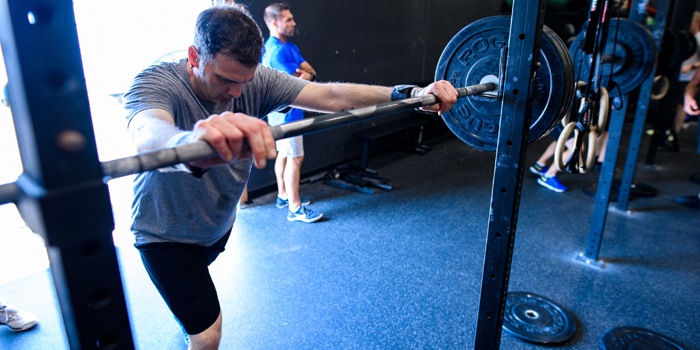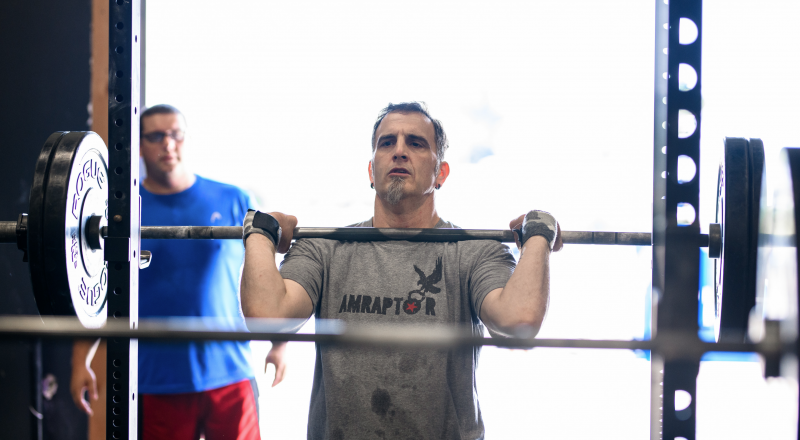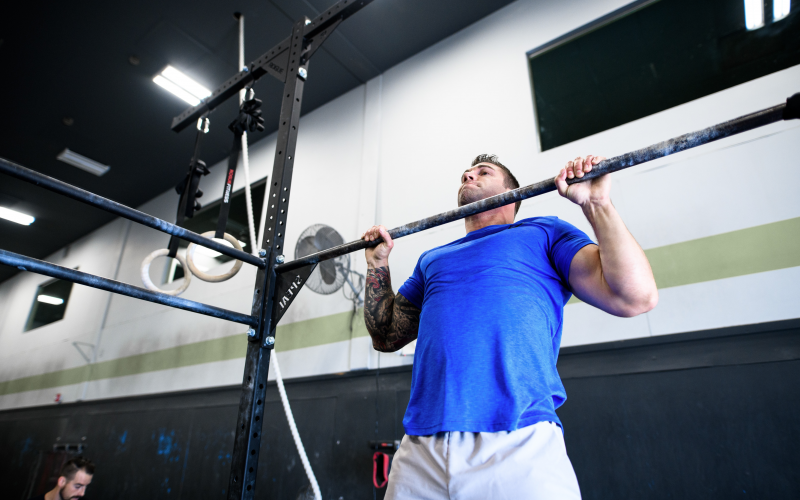
One of the criticisms of the conjugate method is the lack of volume done with compound movements. While athletes can still make great progress without adding more volume to multi-joint movements and simply rely on special exercises for higher-volumes of work, there is certainly a value to performing sub-maximal rep-work with compound movements, particularly with newer athletes that simply need to reinforce good movement patterns.
This lack of volume is deemed by many coaches to not be enough to elicit a strength and/or hypertrophy adaptation. Those who do use the conjugate method know that they incur the large majority of our volume via special exercises, but higher-rep maxes certainly have a place in the program.
RECENT: Why Strength Training is Equally Important as Conditioning (With Template)
First off, we need to consider your goals — and if you're a coach, the athlete whom you're dealing with. Clearly, the needs of a competitive powerlifter are going to differ from your average joe who just wants to look better. The folks I deal with are the people whose primary goal is body composition, but strength may be of equal importance. These people are typically former athletes who still like to remain competitive with themselves. While they aren't looking to hit all-time personal records in the squat, bench, and deadlift, seeing measurable progress is still important.
It makes us feel like we are still moving forward, and for these folks, having an attainable goal keeps the motivation consistent. These people typically don't have more than four to five total hours a week to train, as their lives outside of the gym are busy, to say the least. If this sounds like you, keep reading.
In this case, higher-rep work can be beneficial, but it needs to be properly managed. We are still going to use 1-rep maxes for our primary means of developing intra/intermuscular coordination, but there are a few strategies we can use to ensure we incur extra volume when needed.

A Few Considerations
Movement Demand
I don't have to explain the differences between a deadlift and a press, or even a deadlift and a back squat, for that matter, as the demand on the body differs greatly. Now clearly no two individuals are the same in terms of resiliency, but when it comes to longevity, I'm not a fan of performing higher-rep sets with a movement like a deadlift with near maximal loads. I know plenty of athletes who have no issues with high-rep/near maximal deadlifts, but as a coach who’s considering the needs of the greater good, the risk is greater than the reward.
Movement Sequence
What your programming consists of on a given day will clearly dictate the placement of higher-rep work. For example, you'd be hard-pressed to find any higher-rep work between movements on a dynamic-effort lower-body training day, i.e., between box squats and speed pulls, as the interference will likely impair the objectives of that training session.
Frequency
You may be thinking, “Is this something I could do in every training session?” I hate to say, but it depends; there are many things to consider like goals, training age, and/or injury history. Long story short, higher-rep work could certainly be used weekly in your programming.
Autoregulation
Nothing new here, but listening to your body is crucial to your success. There are going to be times that lower-volume work is in order (max-effort work is intended to be lower-volume), so it's important to not get your mind wrapped around the "more is more" notion because we know that's one of the biggest fallacies in the fitness industry.
1-Rep Maxes
Build to a heavy triple before taking three to four attempts at a new 1RM. Sounds simple, right? Well, it is and simply doing so can add additional volume to your max-effort work. I'll preface this notion by saying that the heavy triple is not a 3RM and should not impair your ability to hit a new 1RM. I'll also say that I do not use this strategy when it comes to performing max-effort deadlift variations as this could potentially impair your ability to successfully hit a new 1RM.
Here's an example:
Max Effort Lower
- Parallel Box Squat: 1RM. Previous 1RM of 405.
- Sets of: 135 x 5, 185 x 3, 225 x 3, 275 x 3, 315 x 3, 335 x 3, 355 x 3, 365 x 1, 385 x 1, 410 x 1, 415 x 1.
Typically I'd go right from 315 to 365 and start performing singles, but in this case, we are simply adding a few additional sets. Again, you'll need to go by feel to ensure your "challenging" sets do not become "maximal” sets. This extra volume does not look like much, but in this case, we are essentially adding an extra 2,000 pounds of volume to our day. Over the course of 12 weeks of training, this volume will start to add up.
Multiple Rep Maxes
I do include multiple rep maxes from time to time. For myself, I'm very explosive, so there is a bigger drop off when it comes to loads I can handle for a 1RM vs. a 3RM. If this is the case for you, keep in mind that it could be a hit to your ego and have you thinking you're going backward with your progress. Again, I rarely (only one included below) perform multiple rep maxes for the deadlift, but pressing and squatting variations make appearances pretty regularly.
A few caveats to multiple rep maxes:
- Have a precise plan in place before starting your sets with an idea of how you'll progress.
- Form should always take precedence so be smart.
- Know what your body responds best to in order to determine what rep-max will actually have a carryover to your goals. For instance, less explosive athletes may get more results from higher rep maxes (5 or more), whereas more explosive athletes may receive more benefit from lower-rep maxes (5 or less.)
Of course, changing your variations and rep-schemes weekly will allow you to avoid accommodation and decrease the risk of injury, so don't get stuck using the same parameters over and over; with the use of accommodating resistance and/or specialty bars, you should have an endless supply of variations.
Some of my favorites include:
- Low Front Box Squat: 3RM
- Close Grip Bench Press with Chains: 5RM
- Anderson Front Squat Off Low Pins: 2RM
- Touch n Go Sumo Deadlift Against Bands off 2-inch Blocks: 10RM
- Push Press: 4RM
- High Box Squat: 5RM
- Wide Stance Good Morning: 5RM
- Paused Back Squat: 3RM
- Bench Press Off Pins with Bands: 6RM
- Drop Sets
Adding drop sets from to time can be a nice change of pace. They work well for a number of reasons since you already have your equipment set up and your body prepared. I've done this both on Max Effort days and Dynamic Effort days with great success, but will say I tend to use drop sets more on ME training days than I do on DE training days. Much like performing multiple rep maxes, this will greatly differ for each individual in terms of what loading parameters to use, and I do not use drop-sets in every training session – usually about two to three times a month.

Here are a few examples:
Dynamic Effort Upper
- Speed Bench Press: 8 x 3 @45% of 1RM + 25% of band tension followed by 1 set of max reps done with your weakest grip pausing for a 1 count on the chest on each rep.
- Speed Push Press: 5 x 3 @75% + 1 set of max reps done touch n go style @60% of 1RM.
- Speed Neutral Grip Pull-ups: 5 x 3 + 1 set of max reps close grip chin-up.
Max Effort Lower
- Box Squat: 1RM + 1 x max reps at 70% of the achieved max.
- Front Squat with Chains: 1RM + 2 x 4 @85% of achieved max with same chains.
- Paused Back Squat: 1RM + 1 set of Max Reps with 80% achieved max, no pause.
Max Effort Upper
- Floor Press: 1RM + 1 drop set at 70% of achieved 1RM x max reps.
- Incline Bench Press: 3RM + 2 drop set at 80% of 3RM x 5 reps per set.
- Pull-up: 1RM + 1 drop set max reps wide pronated grip + 1 drop set max reps neutral grip + 1 drop set max reps chin-up grip.
Cluster Sets
Cluster sets have been used by Olympic lifters for decades. The purpose of cluster-work is to use intra-set rests between reps to increase volume with appreciable loading while maintaining movement quality. Although I don't use cluster sets more than a few times a month, I've found their use to be effective with (from a hypertrophy standpoint) with movements like pull-ups, dips, and dead-stop movements.
Here are a few examples:
- Fat Grip Pull-up Clusters: 5 x 3.2.1 (10s). Rest 2 minutes. *You'll rest 10s between sets and then 2 minutes after all 3 cluster-sets.
- Bench Press Off of Pins: Build to a heavy 1.1.1 (5s). Rest 2 minutes.
- Bar Dips: 4 x 3.3.3 (10s). Rest 2 minutes.
- Front Squat: 5 x 1.1.1 (20s). Rest 3 minutes.
You can vary the sets/reps/movement choice, but keep in mind that as a general rule of thumb we'll be resting between 10 to 20 seconds between clusters. While cluster sets are an easy way to add volume, this work will likely take the place of your max-effort work and are not done in conjunction with maximal-effort work. With general population programming, cluster sets have been very effective to improve neuromuscular efficiency, so I couldn't help but mention them in this article.
How Often to Re-Test?
With an endless supply of variations, it gets easy to always perform new stuff and forget about the old stuff. This is a mistake. Keep track of all your records and rotate your variations every 12 to 16 weeks. This is enough time to see a measurable difference. On the other hand, it may show you that what you've been doing isn't working, and it's time to re-evaluate.
Putting it All Together
Hopefully, that gives you some ideas on how to efficiently add some higher-rep work to your programming. Keep in mind that more is not always more and that you can incur plenty of volume via special exercises. But adding some higher-rep work is definitely fun and can have a profound effect on the results you're getting, specifically for newer athletes who could benefit from some simple barbell work to reinforce good movement patterns.
The conjugate method works so well because it prioritizes a rotation of variations and special exercises, so anytime you're trying to add more volume, remember that there is a cost of doing so. It can be as easy as simply rotating in higher-rep maxes from time-to-time or using your ramp-up sets to add a little more volume.










